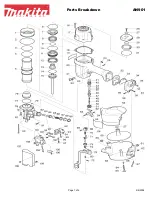
5
ICCONS
®
GAS TOOL GT-6 & GT-6ST USER MANUAL
March 2017 revision 1
2.1 Introduction
The fuel cell is an aerosol product corresponding to
the 2008/47/EC regulations. It contains:
- Liquefied hydrocarbon gases (Butane & Propane).
- Lubricant to help tool work smooth.
2.2 Safety For Handling Fuel Cell
- The fuel cell is always pressurized with
propellant to sustain the fuel supply to the
metering valve, even if the fuel is used up. Its
contents are extremely flammable. The fuel cell
is not reusable. Do not attempt to refill.
- Do not spray towards a flame or an incandescent
body. Keep away from any heat sources and from
electrostatic charges.
- Do not smoke when handling or loading fuel cells.
- Do not expose to temperatures exceeding 50°C.
- Store and use the cartridge in a well-ventilated
area only. Do not inhale.
- Do not pierce or burn the cartridge after use.
- Keep away from children.
- Dispose of only in designated places.
- For optimum performance, use before the date
indicated at the bottom of the cartridge.
2.3 Transport
The regulations by transport categories are:
- Road/Rail: ADR/RID – UN code 2037 class 2.1
- Sea: IMDG – UN code 2037 class 2.1 EmS F-D, S-U
- Air: IATA – UN code 2037 class 2.1
Goods must be accompanied by a transport
emergency card for road UN 2037
Transport by post is not permitted.
2.4 Storage
- Stores and showrooms must comply with building
regulations. All local instructions corresponding
to fire regulations must be followed.
- Where possible, store fuel at stable temperature
in the range: 5 to 25°C. Do not expose to
temperatures exceeding 50°C. Do not use a
tool that emit flames, sparks or reach high
temperatures in the vicinity that fuel cells are
stored.
- Do not store in designated thoroughfares,
hallways or stairwells.
- Store in a well-ventilated area. Fuel cells must
not be displayed in shop windows.
- Storage with pyrotechnic products is not
permitted.
2.5 First Aid
- Direct contact with liquid gas may cause burns or
frostbite.
- In case of inhalation remove the person to fresh
air, and encourage breathing. Should the casualty
become unconscious, or breathing does not
quickly return to normal, summon urgent medical
assistance.
- If gas gets into the eyes they should be flushed
out with copious amounts of water. Skin
contaminations should be removed with soapy
water.
- If symptoms persist, seek medical assistance.
3. THE USE OF BATTERY & CHARGING
SYSTEM
3.1 Introduction
The adaptor, charger and the battery are designed
to operate together as one system.
Only use the
‘ICCONS®’
Adaptor &
‘ICCONS®’
Charger for charging the
‘ICCONS®’
Batteries.
READ INSTRUCTIONS
CLASS II DEVICE
FOR INDOOR USE ONLY
TIME-LAG FUSE-LINK
DISPOSE SEPARATELY FROM
HOUSEHOLD-TYPE WASTE
The charging system is intended to use in covered
areas. Do not expose it to rain or to excessive
humidity.






































